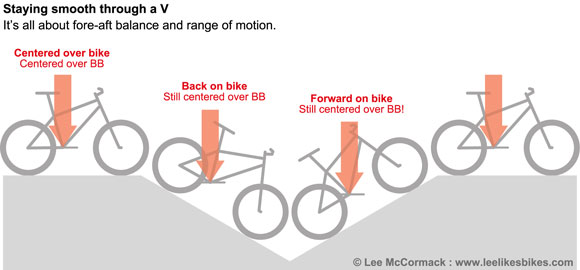Riding through V-shaped terrain

Hi Lee,
I wrote a while back asking advice about hopping the dreaded bucking log. I’m still having some timing issues to get a solid bunny hop going, but after picking up MMBSii, I’ve realized there’s a ship load of pumping and cornering technique for me to master that are really improving my flow! I’ll conquer the log some day.
Anyway, I’m having a hard time with “V” shaped terrain: Steep 15′ or so down to a tiny creek with a few rocks and then back up the other steep side. The bottom of the “V” is narrow enough that my front tire starts going up the other side before my back tire is done going down.
I’m having a very hard time figuring out what to do with my body position and bike while making the transition at the bottom. In fact, I’m not really sure what I’m doing. As the rear tire hits the rocky bottom, I seem to have all 200+ lbs of my weight multiplied on it, making a rough transition that ends up with a pinch flat 1/3rd of the time (that’s better than a few years ago before practicing the heavy feet technique when the forks would bottom out and almost through me over the bars!).
I know you are a busy man with the family and your various bike-related events, but I would be stoked to learn the technique for this type of terrain!
As a side note – I have a hardtail 29er and keep my seat at XC height.
Thanks Lee!
– Eric
Hey Eric,
Thanks for the great question.
What you’re doing
You are shifting your weight back for the Down, which is great, but you’re still back back when you hit the Up. Your rear end is extra heavy, and it’s hitting extra hard.
This is very common. I see it all the time, even with pro riders.
How to fix it
Your situation cuts to the heart of what I’ve been teaching lately.
It’s all about fore-aft balance. Heavy feet, light hands.
– When your bike changes attitude, you have to adjust3 your position to stay balanced above the bottom bracket.
– When you’re going down a steep slope, that means getting way back on the bike.
– When you’re going up a steep slope, that means getting way forward on the bike.
– When the terrain quickly transitions from down to up, you have to adjust your position just as quickly.
– This requires more range and quicker movement than you think is possible.
Here’s why infographic artists get the girls:

|
If you can follow the above advice, this post is worth $600 in private coaching!
Bike setup note
You can learn to move this way with a long cockpit and a high seat, but it’s way easier with a short cockpit and low seat.
Also: Suspension forgives imprecision. Hardtails develop precision.
Mastering Mountain Bike Skills 2nd Edition note
Check out the photos on Page 53. Imagine transitioning quickly and smoothly from the steep down position to the steep up position.
Onward!
— Lee
Know more. Have more fun!
Join the leelikesbikes mailing list:

Comments are closed.